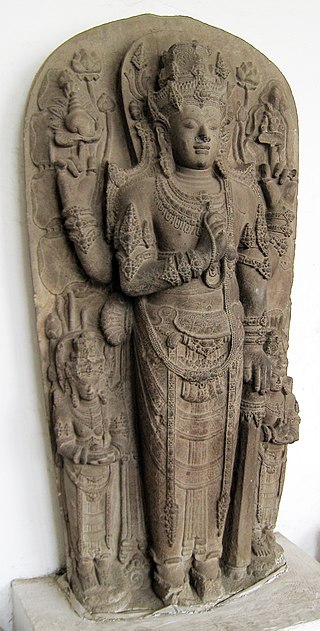
In European Christianity, the divine right of kings, divine right, or God's mandation is a political and religious doctrine of political legitimacy of a monarchy. It stems from a specific metaphysical framework in which a monarch is, before birth, pre-ordained to inherit the crown, chosen by God and in the image of God. According to this theory of political legitimacy, the subjects of the crown have actively turned over the metaphysical selection of the king's soul – which will inhabit the body and rule them – to God. In this way, the "divine right" originates as a metaphysical act of humility and/or submission towards God. Divine right has been a key element of the legitimisation of many absolute monarchies.

The word emperor can mean the male absolute ruler of an empire. Empress, the female equivalent, may indicate an emperor's wife, mother/grandmother, or a woman who rules in her own right and name. Emperors are generally recognized to be of the highest monarchic honor and rank, surpassing kings. In Europe, the title of Emperor has been used since the Middle Ages, considered in those times equal or almost equal in dignity to that of Pope due to the latter's position as visible head of the Church and spiritual leader of the Catholic part of Western Europe. The Emperor of Japan is the only currently reigning monarch whose title is translated into English as "Emperor".
A monarchy is a form of government in which a person, the monarch, is head of state for life or until abdication. The political legitimacy and authority of the monarch may vary from restricted and largely symbolic, to fully autocratic, and can span across executive, legislative, and judicial domains.
The Chinese sovereign was the ruler of a particular monarchical regime in the historical periods of ancient China and imperial China. Sovereigns ruling the same regime, and descended from the same paternal line, constituted a dynasty. Several titles and naming schemes have been used throughout Chinese history.

An imperial cult is a form of state religion in which an emperor or a dynasty of emperors are worshipped as demigods or deities. "Cult" here is used to mean "worship", not in the modern pejorative sense. The cult may be one of personality in the case of a newly arisen Euhemerus figure, or one of national identity or supranational identity in the case of a multi-ethnic state. A divine king is a monarch who is held in a special religious significance by his subjects, and serves as both head of state and a deity or head religious figure. This system of government combines theocracy with an absolute monarchy.

In Japanese religion, Yahata formerly in Shinto and later commonly known as Hachiman is the syncretic divinity of archery and war, incorporating elements from both Shinto and Buddhism.
In many historical societies, the position of kingship carries a sacral meaning; that is, it is identical with that of a high priest and judge. The concept of theocracy is related, although a sacred king does not need to necessarily rule through his religious authority; rather, the temporal position itself has a religious significance behind it.

Apotheosis, also called divinization or deification, is the glorification of a subject to divine levels and, commonly, the treatment of a human being, any other living thing, or an abstract idea in the likeness of a deity. The term has meanings in theology, where it refers to a belief, and in art, where it refers to a genre.

Traditional rank amongst European royalty, peers, and nobility is rooted in Late Antiquity and the Middle Ages. Although they vary over time and among geographic regions, the following is a reasonably comprehensive list that provides information on both general ranks and specific differences. Distinction should be made between reigning families and the nobility – the latter being a social class subject to and created by the former.

Basileus is a Greek term and title that has signified various types of monarchs in history. In the English-speaking world it is perhaps most widely understood to mean "monarch", referring to either a "king" or an "emperor" and also by bishops of the Eastern orthodox church and Eastern Catholic Churches. The title was used by sovereigns and other persons of authority in ancient Greece, the Byzantine emperors, and the kings of modern Greece.
A cult is a religious or social group with socially deviant or novel beliefs and practices.

Son of Heaven, or Tianzi, was the sacred monarchical title of the Chinese sovereign. It originated with the Zhou dynasty and was founded on the political and spiritual doctrine of the Mandate of Heaven. Since the Qin dynasty, the secular imperial title of the Son of Heaven was "Huangdi".

The Roman imperial cult identified emperors and some members of their families with the divinely sanctioned authority (auctoritas) of the Roman State. Its framework was based on Roman and Greek precedents, and was formulated during the early Principate of Augustus. It was rapidly established throughout the Empire and its provinces, with marked local variations in its reception and expression.

Inti is the ancient Inca sun god. He is revered as the national patron of the Inca state. Although most consider Inti the sun god, he is more appropriately viewed as a cluster of solar aspects, since the Inca divided his identity according to the stages of the sun. Worshiped as a patron deity of the Inca Empire, Pachacuti is often linked to the origin and expansion of the Inca Sun Cult. The most common belief was that Inti was born of Viracocha, who had many titles, chief among them being the God of Creation.

Augustus was an ancient Roman title given as both name and title to Gaius Julius Caesar Octavianus, Rome's first Emperor. On his death, it became an official title of his successor, and was so used by Roman emperors thereafter. The feminine form Augusta was used for Roman empresses and other female members of the Imperial family. The masculine and feminine forms originated in the time of the Roman Republic, in connection with things considered divine or sacred in traditional Roman religion. Their use as titles for major and minor Roman deities of the Empire associated the Imperial system and Imperial family with traditional Roman virtues and the divine will, and may be considered a feature of the Roman Imperial cult.
A universal monarchy is a concept and political situation where one monarchy is deemed to have either sole rule over everywhere or to have a special supremacy over all other states.

"Devarāja" was a religious order of the "god-king," or deified monarch in medieval Southeast Asia. The devarāja order grew out of both Hinduism and separate local traditions depending on the area. It taught that the king was a divine universal ruler, a manifestation of Bhagawan. The concept viewed the monarch to possess transcendental quality, the king as the living god on earth. The concept is closely related to the Bharati concept of Chakravartin. In politics, it is viewed as the divine justification of a king's rule. The concept was institutionalized and gained its elaborate manifestations in ancient Java and Cambodia, where monuments such as Prambanan and Angkor Wat were erected to celebrate the king's divine rule on earth.

Chinese theology, which comes in different interpretations according to the classic texts and the common religion, and specifically Confucian, Taoist, and other philosophical formulations, is fundamentally monistic, that is to say it sees the world and the gods of its phenomena as an organic whole, or cosmos, which continuously emerges from a simple principle. This is expressed by the concept that "all things have one and the same principle". This principle is commonly referred to as Tiān 天, a concept generally translated as "Heaven", referring to the northern culmen and starry vault of the skies and its natural laws which regulate earthly phenomena and generate beings as their progenitors. Ancestors are therefore regarded as the equivalent of Heaven within human society, and therefore as the means connecting back to Heaven which is the "utmost ancestral father". Chinese theology may be also called Tiānxué 天學, a term already in use in the 17th and 18th centuries.
[In contrast to the God of Western religions who is above the space and time] the God of Fuxi, Xuanyuan, and Wang Yangming is under in our space and time. ... To Chinese thought, ancestor is creator.

The Wǔfāng Shàngdì, or simply Wǔdì or Wǔshén are, in Chinese canonical texts and common Chinese religion, the fivefold manifestation of the supreme God of Heaven. This theology dates back at least to the Shang dynasty. Described as the "five changeable faces of Heaven", they represent Heaven's cosmic activity which shapes worlds as tán 壇, "altars", imitating its order which is visible in the starry vault, the north celestial pole and its spinning constellations. The Five Deities themselves represent these constellations. In accordance with the Three Powers they have a celestial, a terrestrial and a chthonic form. The Han Chinese identify themselves as the descendants of the Red and Yellow Deities.













